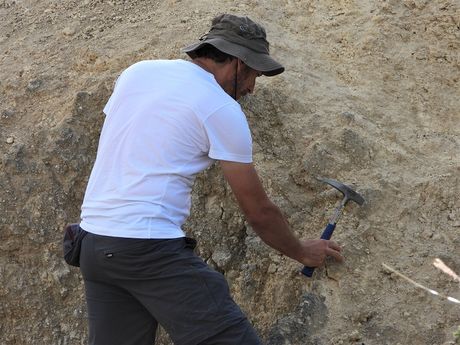Pannonian fossils, up to 20 million years old, found on Fruska Gora: Sea was not salty afterwards

On September 24, experts from the Provincial Institute for Nature Protection found several fossils of shells from the Pannonian Sea up to 20 million years old, discovered at the geological-paleontological site Krecanska Jama near Lezimir on Fruska Gora.
According to Darko Timotic, a geology engineer for paleontology with the Provincial Institute for Nature Protection, this is a site that has long been in the records of the institute.
"It's a site where limestone was mined in the past, so that people could make lime, which is probably why it's called Krecanske Jame ("Lime Pits" in Serbian). There are a lot of fossils at that site because it dates back to the period of the Pannonian Sea, when there was the largest number of fossils and they were mostly shells and algae. That was the real Pannonian Sea, up to 20 million years ago. After that, there were some tectonic movements when that sea was no longer a real sea, as there was more and more fresh water inflow," Darko Timotic told Telegraf.rs.
Shells are often found there, says the geologist. These are the real sea layers of the Pannonian Sea, because after that period there were no more such sediments and marine organisms on Mt. Fruska Gora, the environment changed - so this site is important.
The fossils fall out on their own
"What is especially interesting is that it's best to come here after the winter, in the spring or summer, because these rocks are very porous and during the winter when there is snow and ice, it often happens that fossils are literally found on the surface and outside the profile, having fallen out. Water enters that space between the rock and the fossil and pushes it to the surface. A good number of fossils were found precisely in that way rather than on the profile itself, instead below the profile in that crushed material. That is what we geologists know, while most people go there and knock on something, look for it, but the best way is this," explains Timotic.
According to him, the company Lafarge did some research on that site looking for limestone, and to what degree that site will be available at all depends on their results.
After processing and cleaning, which can take up to several weeks, the fossils will be placed in the geological-paleontological collection of the Provincial Institute.
Pannonian Sea, from Vienna to the Carpathians
The Pannonian Sea existed in the Pannonian Basin from 23 until 1.8 million years ago. It stretched between Vienna in the west, the Slovak Tatras in the north, the Romanian Carpathian Mountains in the east and the Dinaric Alps in the south. The Danube at the time flowed into the sea near Vienna, the Sava was a short tributary, and the course of Drina, Kolubara and Morava rivers was even shorter, writes tourist guide and geographer Ratomir Veselinovic. The last waters of the Pannonian Sea drained out in the Danube towards the Black Sea, and the last time time there was sea at what is today Belgrade was approximately 8 million years ago. If, by any chance, our capital existed at that time, only its highest parts, such as Mt. Avala, Torlak and Vracar, would peek out of the water.
This body of water covered a significant part of Serbia - Vojvodina, Sumadija, Pomoravlje - as well as the area of today's northern and eastern Croatia and Bosnia and Herzegovina, northeastern parts of Slovenia (Prekomurje), eastern parts of Austria, western Slovakia, extreme south of the Czech Republic, almost all of Hungary, western Romania, and a part of Transcarpathian Ukraine.
Today, as evidence of the existence of the Pannonian Sea, we have the Hungarian Lake Balaton, the Djerdap Gorge on the Danube, the Black Sea, the Aral Sea, Bizovac Spa, salt deposits in Tuzla, oil and gas deposits in Serbia and Croatia...
(Telegraf.rs)
Video: Kula Beograd u znaku Jovana Jovanovića Zmaja
Telegraf.rs zadržava sva prava nad sadržajem. Za preuzimanje sadržaja pogledajte uputstva na stranici Uslovi korišćenja.

